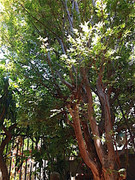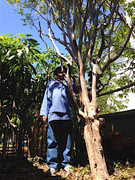4176
Tropical Fruit Discussion / Re: Sharpshooters major vector for disease in Mangos in California?
« on: July 22, 2016, 02:40:57 AM »
You're welcome Raul and JF. Knlimooo, some of the pictures you posted are definitely sharpshooter damage and it does appear that some of the wounds got infected with fungus, primarily the wounds that turn dark.
I was going to post some pictures of sharpshooter damage and progression of wounds but I can't seem to be able to post pictures at the moment.
Anyways, this is exactly what I'm talking about. I believe that sharpshooters are a major vector for disease in mangos and we have to be proactive in this fight.
I'm still trying to narrow down which systemic fungicide to use.
Simon
I was going to post some pictures of sharpshooter damage and progression of wounds but I can't seem to be able to post pictures at the moment.
Anyways, this is exactly what I'm talking about. I believe that sharpshooters are a major vector for disease in mangos and we have to be proactive in this fight.
I'm still trying to narrow down which systemic fungicide to use.
Simon





